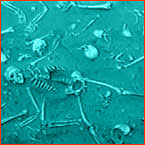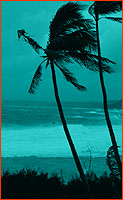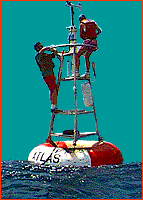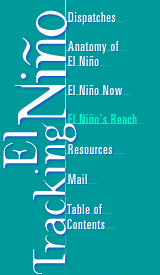Through Time
 2,200 BC
2,200 BC
A massive drought, a possible El Niño, leaves its signature in a glacier
on an Andean mountain. Dr. Lonnie Thompson recovered a core from this
glacier in 1993, and pinpointed the telltale layer during analysis in
his laboratory.
1000 AD
An unusually large El Niño leaves its calling card in the growth rings of
trees 6,000 miles apart; tree ring samples gathered in northern Arizona by
scientists at the Lamont Doherty Earth Observatory show the same growth
patterns as samples retrieved from Santiago, Chile.
 ca. 1500
ca. 1500
Eighty people are sacrificed by the Incas. Dr. Steve Bourget from the
University of East Anglia recently excavated the burial pit, and put
together the evidence that a frightened populace was trying to appease an
angry sea god during a strong El Niño.
1567
Spanish conquistadors in Peru create the first written records of El Niño.
Some historians speculate that the ruthless Pizarro, who brought down the
Incan empire, might have failed were it not for El Niño bringing rain-and
horse fodder-to a normally arid land.
1600-1650
X-ray analysis by Dr. Julia Cole, of coral cores drilled in the Galapagos
Islands, shows that 300 years ago, El Niño events were half as frequent as
they are today. It is not known why.
1835
The only hurricane ever recorded in Los Angeles strikes on August 23, and
obliterates the settlement there. "Proxy" evidence in tree rings and lake
sediments also suggests 1835 was an El Niño year.
 Late 19th century
Late 19th century
Peruvian fishermen begin referring to the periodic warming of the sea at
Christmas as El Niño, meaning "The Child," or "The Little One." Frequently,
the Child chases the fish away—but causes the desert to bloom. The term
"El Niño" appears in print for the first time in 1892 in a Peruvian
scientific journal.
1899
Massive famine strikes India as the monsoons fail during an El Niño year.
Uncounted thousands die directly from starvation, and many more die in the
epidemic of cholera and plague that follow.
 1904
1904
The head of the Indian Meteorological Service, Sir Gilbert Walker, is asked
to find a way to predict monsoon failure. Walker concedes that it may take
time, but he begins sorting through weather records, looking for a pattern.
1920s
Sir Gilbert finally finds what he has spent two decades searching for. He
is able to correlate rainfall in South America with periodic changes in
ocean temperatures. He also finds a near-perfect mirror-image connection
between barometer readings at stations on Tahiti and Darwin, Australia; as
pressure rises in the east, it falls in the west. He coins the term
Southern Oscillation to dramatize the ups and downs in this east-west
seesaw effect. He also finds linkages between the Asian monsoon season,
drought in Australia and parts of Africa, and mild winters in western
Canada.
1962
Freida, a western Pacific typhoon, crosses the entire ocean (against what
should have been prevailing winds) and slams into Oregon, an event never
recorded before or since. Some researchers link the typhoon's strange
behavior to upper-atmosphere disturbances rooted in the El Niño-La Niña
cycle.
 1969
1969
Norwegian meteorologist Jacob Bjerknes is the first to see a connection
between unusually warm sea-surface temperatures in El Niño and the weak
easterlies and heavy rainfall that accompany Southern Oscillation
conditions. Ultimately, Bjerknes' discovery leads to the recognition that
the warm waters of El Niño and the pressure seesaw of Walker's Southern
Oscillation are facets of the same phenomenon, sometimes referred to by the
acronym ENSO, or El Niño/Southern Oscillation.
 1982
1982
The most powerful El Niño of the century (until 1997) strikes without
warning. Strongly teleconnected to California rainfall, it generates wave
after wave of punishing storms which soak the west coast, wash away
beaches, create floods and mudslides, while creating mild wet conditions in
the midwest and north. Worldwide, El Niño storms do fifteen billion
dollars of damage, and cost 2000 people their lives.
 1994
1994
The TOGA/TAO buoy array becomes fully operational in the tropical Pacific
Ocean. It is the first real-time instrument for detecting the initial
advance of El Niño.
1997 (early)
The top computer model predicts no El Niño. Nevertheless, in March
TOGA/TAO detects, and satellites confirm, that an unusually strong El Niño
is at the starting gate...



 2,200 BC
2,200 BC ca. 1500
ca. 1500  Late 19th century
Late 19th century  1904
1904 1969
1969 1982
1982 1994
1994